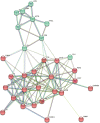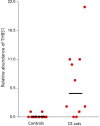Serum proteome profiles in cats with chronic enteropathies
- PMID: 37279179
- PMCID: PMC10365053
- DOI: 10.1111/jvim.16743
Serum proteome profiles in cats with chronic enteropathies
Abstract
Background: Serum protein biomarkers are used to diagnose, monitor treatment response, and to differentiate various forms of chronic enteropathies (CE) in humans. The utility of liquid biopsy proteomic approaches has not been examined in cats.
Hypothesis/objectives: To explore the serum proteome in cats to identify markers differentiating healthy cats from cats with CE.
Animals: Ten cats with CE with signs of gastrointestinal disease of at least 3 weeks duration, and biopsy-confirmed diagnoses, with or without treatment and 19 healthy cats were included.
Methods: Cross-sectional, multicenter, exploratory study with cases recruited from 3 veterinary hospitals between May 2019 and November 2020. Serum samples were analyzed and evaluated using mass spectrometry-based proteomic techniques.
Results: Twenty-six proteins were significantly (P < .02, ≥5-fold change in abundance) differentially expressed between cats with CE and controls. Thrombospondin-1 (THBS1) was identified with >50-fold increase in abundance in cats with CE (P < 0.001) compared to healthy cats.
Conclusions and clinical importance: Damage to the gut lining released marker proteins of chronic inflammation that were detectable in serum samples of cats. This early-stage exploratory study strongly supports THBS1 as a candidate biomarker for chronic inflammatory enteropathy in cats.
Keywords: alimentary small cell lymphoma; biomarkers; chronic enteropathies; low-grade alimentary lymphoma; proteins; proteomics.
© 2023 The Authors. Journal of Veterinary Internal Medicine published by Wiley Periodicals LLC. on behalf of the American College of Veterinary Internal Medicine.
Conflict of interest statement
Authors declare no conflict of interest.
Figures




References
-
- Marsilio S. Feline chronic enteropathy. J Small Anim Pract. 2021;62:409‐419. - PubMed
-
- Norsworthy GD, Estep JS, Hollinger C, et al. Prevalence and underlying causes of histologic abnormalities in cats suspected to have chronic small bowel disease: 300 cases (2008‐2013). J Am Vet Med Assoc. 2015;247:629‐635. - PubMed
-
- Jergens AE, Crandell JM, Evans R, Ackermann M, Miles KG, Wang C. A clinical index for disease activity in cats with chronic enteropathy. J Vet Intern Med. 2010;24:1027‐1033. - PubMed
Publication types
MeSH terms
Substances
Grants and funding
LinkOut - more resources
Full Text Sources
Miscellaneous

